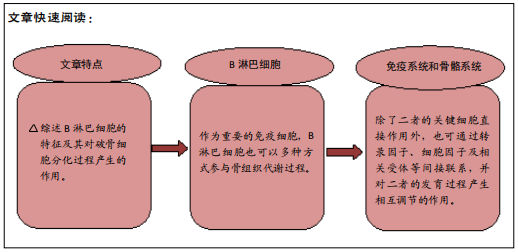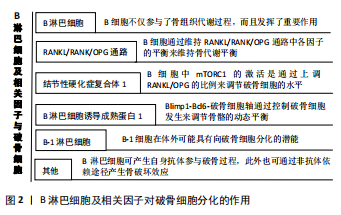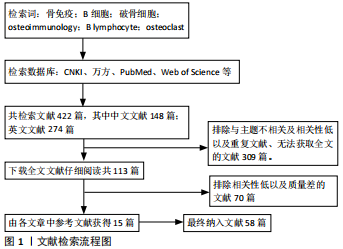[1] TAKAYANAGI H. New developments in osteoimmunology. Nat Rev Rheumatol. 2012;8(11):684-689.
[2] SCHETT G, GRAVALLESE E. Bone erosion in rheumatoid arthritis: mechanisms, diagnosis and treatment. Nat Rev Rheumatol. 2012;8(11): 656-664.
[3] MARINOVA-MUTAFCHIEVA L, WILLIAMS RO, FUNA K, et al. Inflammation is preceded by tumor necrosis factor-dependent infiltration of mesenchymal cells in experimental arthritis. Arthritis Rheum. 2002;46(2):507-513.
[4] ARRON JR, CHOI Y. Bone versus immune system. Nature. 2000;408 (6812):535-536.
[5] Sims NA, Vrahnas C. Regulation of cortical and trabecular bone mass by communication between osteoblasts, osteocytes and osteoclasts.Arch Biochem Biophys. 2014;561:22-28.
[6] 刘伟,宋慧,董鹏.骨免疫学研究进展[J].骨科临床与研究杂志, 2020,5(2):124-126.
[7] TAICHMAN R, REILLY M, VERMA R, et al. Hepatocyte growth factor is secreted by osteoblasts and cooperatively permits the survival of haematopoietic progenitors. Br J Haematol. 2001;112(2):438-448.
[8] VISNJIC D, KALAJZIC I, GRONOWICZ G, et al. Conditional ablation of the osteoblast lineage in Col2.3deltatk transgenic mice. J Bone Miner Res. 2001;16(12):2222-2231.
[9] ALNAEELI M, PENNINGER JM, TENG YT. Immune interactions with CD4+ T cells promote the development of functional osteoclasts from murine CD11c+ dendritic cells. J Immunol. 2006;177(5):3314-3326.
[10] 王凌,李大金.免疫活性细胞对骨代谢的调控作用[J].中国免疫学杂志,2006,22(3):287-290.
[11] 喻晶. IFN-γ对小鼠破骨细胞前体CXCR4表达的调节及意义[D].武汉:华中科技大学,2010.
[12] 董锡亮,赵宏斌.IL-4抑制骨吸收的研究进展[J].中国老年学杂志, 2009,29(5):634-636.
[13] BRIOLAY A, LENCEL P, BESSUEILLE L, et al. Autocrine stimulation of osteoblast activity by Wnt5a in response to TNF-α in human mesenchymal stem cells. BiochemBiophys Res Commun. 2013;430(3): 1072-1077.
[14] TAKAYANAGI H. Osteoimmunology and the effects of the immune system on bone. Nat Rev Rheumatol. 2009;5(12):667-676.
[15] MEEDNU N, ZHANG H, OWEN T, et al. Production of RANKL by Memory B Cells: A Link Between B Cells and Bone Erosion in Rheumatoid Arthritis. Arthritis Rheumatol. 2016;68(4):805-816.
[16] 贾淑媛,李萍.淋巴细胞亚群在类风湿关节炎患者外周血中的表达及意义[J].中国实验诊断学,2019,23(11):1943-1946.
[17] WHEATER G, HOGAN VE, TENG YK, et al. Suppression of bone turnover by B-cell depletion in patients with rheumatoid arthritis. OsteoporosInt. 2011;22(12):3067-3072.
[18] BOUMANSM J, THURLINGSR M, YEO L, et al. Rituximab abrogates joint destruction in rheumatoid arthritis by inhibiting osteoclastogenesis.Ann Rheum Dis. 2012;71(1):108-113.
[19] ROSSI SW, KIM MY, LEIBBRANDT A, et al. RANK signals from CD4(+)3(-) inducer cells regulate development of Aire-expressing epithelial cells in the thymicmedulla. J ExpMed. 2007;204(6):1267-1272.
[20] LI J, SAROSI I, YAN XQ, et al. RANK is the intrinsic hematopoietic cell surface receptor that controls osteoclastogenesis and regulation of bone mass and calcium metabolism. Proc Natl AcadSci U S A. 2000; 97(4):1566-1571.
[21] TAKAHASHI N, AKATSU T, UDAGAWA N, et al. Osteoblastic cells are involved in osteoclast formation. Endocrinology. 1988;123(5):2600-2602.
[22] YASUDA H, SHIMA N, NAKAGAW AN, et al. Osteoclast differentiation factor is a ligand for osteoprotegerin/osteoclastogenesis-inhibitory factor and is identical to TRANCE/RANKL. Proc Natl AcadSci U S A. 1998; 95(7):3597-3602.
[23] O’BRIEN CA. Control of RANKL gene expression. Bone. 2010;46(4):911-919.
[24] WAL SH MC, KIM N, KADONO Y, et al. Osteoimmunology: interplay between the immune system and bone metabolism. Annu Rev Immunol. 2006;24:33-63.
[25] MANABE N, KAWAGUCHI H, CHIKUDA H, et al. Connection between B lymphocyte and osteoclast differentiation pathways.J Immunol. 2001; 167(5):2625-2631.
[26] YOSHIDA H, HAYASHI S, KUNISADA T, et al.The murine mutation osteopetrosis is in the coding region of the macrophage colony stimulating factor gene. Nature. 1990;345(6274):442-444.
[27] 陈之光,薛今琦,付勤.干扰素-γ在骨免疫系统中作用的研究进展[J].中国骨质疏松杂志,2015,21(3):361-366.
[28] DOUGALL WC, GLACCUM M, CHARRIER K, et al. RANK is essential for osteoclast and lymph node development. Genes Dev. 1999;13(18): 2412-2424.
[29] SIMONET WS, LACEY DL, DUNSTAN CR, et al. Osteoprotegerin: a novel secreted protein involved in the regulation of bone density. Cell. 1997; 89(2):309-319.
[30] LI Y, TORALDO G, LI A, et al. B cells and T cells are critical for the preservation of bone homeostasis and attainment of peak bone mass in vivo. Blood. 2007;109(9):3839-3848.
[31] ONAL M, XIONG J, CHEN X, et al. Receptor activator of nuclear factor κB ligand (RANKL) protein expression by B lymphocytes contributes to ovariectomy-induced bone loss .J BiolChem. 2012;287(35):29851-29860.
[32] HUANG J, MANNING BD. TheTSC1-TSC2 complex: a molecular switchboard controlling cell growth. BiochemJ. 2008;412(2):179-190.
[33] HUANG B, WANG Y, WANG W, et al. mTORC1 Prevents Preosteoblast Differentiation through the Notch Signaling Pathway. PLoS Genet. 2015;11(8):e1005426.
[34] CHEN J, LONG F. mTOR signaling in skeletal development and disease. Bone Res. 2018;6:1.
[35] LIU W, WANG Z, YANG J, et al. OsteocyteTSC1 promotes sclerostin secretion to restrain osteogenesis in mice. OpenBiol. 2019;9(5):180262.
[36] XU S, ZHANG Y, LIU B, et al. Activation of mTORC1 in B Lymphocytes Promotes Osteoclast Formation via Regulation of β-Catenin and RANKL/OPG. J Bone Miner Res. 2016;31(7):1320-1333.
[37] TURNER CA JR, MACK DH, DAVIS MM. Blimp-1, a novel zinc finger-containing protein that can drive the maturation of B lymphocytes into immunoglobulin-secreting cells. Cell. 1994;77(2):297-306.
[38] 刘国生,王姣平,褚志华,等.骨髓单个核细胞中B淋巴细胞诱导成熟蛋白-1表达对多发性骨髓瘤患者预后的影响[J].中国实验血液学杂志,2017,25(5):1449-1453.
[39] NISHIKAWA K, NAKASHIMA T, HAYASHI M, et al. Blimp1-mediated repression of negative regulators is required for osteoclast differentiation. Proc Natl AcadSci U S A. 2010;107(7):3117-3122.
[40] MARTINS G, CALAME K. Regulation and functions of Blimp-1 in T and B lymphocytes. Annu Rev Immunol. 2008;26:133-169.
[41] WU L, GUO Q, YANG J, et al. Tumor Necrosis Factor Alpha Promotes Osteoclast Formation Via PI3K/AktPathway-Mediated Blimp1 Expression Upregulation. J Cell Biochem. 2017;118(6):1308-1315.
[42] ZHAO N, TSUDA H, MUROFUSHI T, et al. Chaetocin inhibits RANKL-induced osteoclast differentiation through reduction of Blimp1 in Raw264.7cells. Life Sci. 2015;143:1-7.
[43] GINALDIL, DE MARTINIS M, SAITTA S, et al. Interleukin-33 serum levels in postmenopausal women with osteoporosis. Sci Rep. 2019;9(1):3786.
[44] KIYOMIYA H, ARIYOSHI W, OKINAGA T, et al. IL-33 inhibits RANKL-induced osteoclast formation through the regulation of Blimp-1 and IRF-8 expression. BiochemBiophys Res Commun. 2015;460(2):320-326.
[45] JEONG E, KIM J, GO M, et al. Early estrogen-induced gene 1 facilitates osteoclast formation through the inhibition of interferon regulatory factor 8 expression. FASEB J. 2020;34(9):12894-12906.
[46] MIYAUCHI Y, NINOMIYA K, MIYAMOTO H, et al. The Blimp1-Bcl6 axis is critical to regulate osteoclast differentiation and bone homeostasis. J Exp Med. 2010;207(4):751-762.
[47] HARDY RR, HAYAKAWA K, HAAIJMAN J, et al. B-cell subpopulations identified by two-colour fluorescence analysis. Nature. 1982;297(5867): 589-591.
[48] WALDSCHMIDT TJ, KROESE FG, TYGRETT LT, et al. The expression of B cell surface receptors. III. The murine low-affinity IgE Fc receptor is not expressed on Ly 1 or ‘Ly 1-like’ B cells. Int Immunol. 1991;3(4):305-315.
[49] STALL AM, ADAMS S, HERZENBERG LA, et al. Characteristics and development of the murine B-1b (Ly-1 B sister) cell population. Ann N Y AcadSci. 1992;651:33-43.
[50] BOGSAN CS, NOVAES E BRITO RR, PALOS MDA C, et al. B-1 cells are pivotal for in vivo inflammatory giant cell formation. Int J Exp Pathol. 2005;86(4):257-265.
[51] PUGLIESE LS, GONÇALVES TO, POPIAF, et al. B-1 lymphocytes differentiate into functional osteoclast-like cells. Immunobiology. 2012;217(3):336-344.
[52] HARRE U, GEORGESS D, BANG H, et al. Induction of osteoclastogenesis and bone loss by human autoantibodies against citrullinatedvimentin. J Clin Invest. 2012;122(5):1791-1802.
[53] KRISHNAMURTHY A, JOSHUA V, HAJHENSVOLD A, et al. Identification of a novel chemokine-dependent molecular mechanism underlying rheumatoid arthritis-associated autoantibody-mediated bone loss. Ann Rheum Dis. 2016;75(4):721-729.
[54] 张益祥,谭心辰,吴耀持.免疫与炎症对破骨细胞分化的影响[J].上海医药,2020,41(14):30-33+55.
[55] HERMAN S, MÜLLER RB, KRÖNKE G, et al. Induction of osteoclast-associated receptor, a key osteoclast costimulationmolecule,in rheumatoid arthritis. Arthritis Rheum. 2008;58(10):3041-3050.
[56] GINALDI L, DE MARTINIS M, CICCARELLI F, et al. Increased levels of interleukin 31 (IL-31) in osteoporosis. BMCImmunol. 2015;16:60.
[57] VISNJIC D, KALAJZIC Z, ROWED W, et al. Hematopoiesis is severely altered in mice with an induced osteoblast deficiency. Blood. 2004; 103(9):3258-3264.
[58] ZHU J, GARRETT R, JUNG Y, et al. Osteoblasts support B-lymphocyte commitment and differentiation from hematopoietic stem cells. Blood. 2007;109(9):3706-3712.
(责任编辑:WZH,ZN,DL)
|


